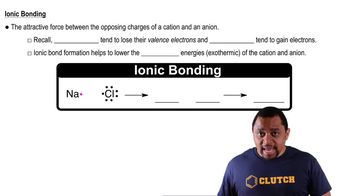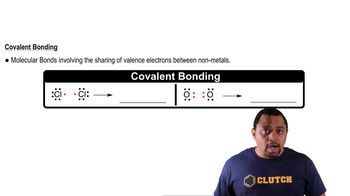In the Chemistry and the Environment box on free radicals in this chapter, we discussed the importance of the hydroxyl radical in reacting with and eliminating many atmospheric pollutants. However, the hydroxyl radical does not clean up everything. For example, chlorofluorocarbons—which destroy stratospheric ozone—are not attacked by the hydroxyl radical. Consider the hypothetical reaction by which the hydroxyl radical might react with a chlorofluorocarbon: OH(g) + CF2Cl2(g) → HOF(g) + CFCl2(g) Use bond energies to explain why this reaction is improbable. (The C–F bond energy is 552 kJ/mol.)
Ch.10 - Chemical Bonding I: The Lewis Model

Chapter 10, Problem 87a
Each compound contains both ionic and covalent bonds. Write ionic Lewis structures for each, including the covalent structure for the ion in brackets. Write resonance structures if necessary. a. BaCO3
 Verified step by step guidance
Verified step by step guidance1
Identify the components of BaCO_3: barium (Ba), carbonate ion (CO_3^{2-}).
Recognize that BaCO_3 is composed of Ba^{2+} and CO_3^{2-} ions, where Ba^{2+} is the cation and CO_3^{2-} is the anion.
Draw the Lewis structure for the carbonate ion (CO_3^{2-}): start with a central carbon atom bonded to three oxygen atoms, and distribute the 24 valence electrons (4 from carbon, 6 from each oxygen, and 2 extra for the 2- charge) to satisfy the octet rule.
Consider resonance structures for CO_3^{2-}: distribute the double bond among the three oxygen atoms, resulting in three equivalent resonance structures.
Combine the ionic and covalent structures: represent Ba^{2+} as a separate ion and enclose the covalent structure of CO_3^{2-} in brackets, indicating the ionic interaction between Ba^{2+} and CO_3^{2-}.

Verified video answer for a similar problem:
This video solution was recommended by our tutors as helpful for the problem above.
Was this helpful?
Key Concepts
Here are the essential concepts you must grasp in order to answer the question correctly.
Ionic Bonds
Ionic bonds are formed through the electrostatic attraction between positively and negatively charged ions. In the case of BaCO3, barium (Ba) donates two electrons to become Ba²⁺, while the carbonate ion (CO3²⁻) accepts these electrons, resulting in a stable ionic compound. Understanding ionic bonding is crucial for drawing accurate Lewis structures.
Recommended video:
Guided course

Chemical Bonds
Covalent Bonds
Covalent bonds occur when two atoms share electrons to achieve a full outer shell, leading to stability. In the carbonate ion (CO3²⁻), carbon shares electrons with three oxygen atoms, forming covalent bonds. Recognizing how covalent bonds function within polyatomic ions is essential for constructing their Lewis structures.
Recommended video:
Guided course

Chemical Bonds
Resonance Structures
Resonance structures are different ways of drawing the same molecule that illustrate the delocalization of electrons. For the carbonate ion (CO3²⁻), resonance structures show that the double bond between carbon and oxygen can be placed between any of the three oxygen atoms. This concept is important for accurately representing the electron distribution in Lewis structures.
Recommended video:
Guided course

Resonance Structures
Related Practice
Textbook Question
Textbook Question
Write an appropriate Lewis structure for each compound. Make certain to distinguish between ionic and molecular compounds. b. ClF5
Textbook Question
Each compound contains both ionic and covalent bonds. Write ionic Lewis structures for each, including the covalent structure for the ion in brackets. Write resonance structures if necessary. b. Ca(OH)2 c. KNO3 d. LiIO
Textbook Question
Carbon ring structures are common in organic chemistry. Draw a Lewis structure for each carbon ring structure, including any necessary resonance structures. a. C4H8 b. C4H4 c. C6H12 d. C6H6
